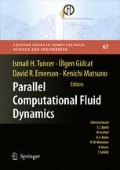Abstract
We present in this paper the experience of the authors in solving very large problems of computational mechanics on a supercomputer. The authors are researchers of the Barcelona Supercomputing Center-Centro Nacional de Supercomputación (BSC-CNS), a brand new research center in Spain, which hosts the fastest supercomputer in Europe and the fifth in the world: MareNostrum (TOP500, November 2006). A brief presentation of MareNostrum is given in the first section. In the next section, we describe the physical problems we are faced with, followed by the section on the associated numerical strategies. Next section presents the parallelization strategy employed; emphasis will be put on the important aspects to obtain good speed-up results on thousands of processors. We follow the discussion by describing some applications together with speed-up results. We finalize the paper by describing the performance tool used at BSC-CNS and their application in computational mechanics.
Preview
Unable to display preview. Download preview PDF.
References
M. Vázquez, G. Houzeaux, R. Grima and J.M. Cela, Applications of Parallel Computational Fluid Mechanics in MareNostrum Supercomputer: Low-Mach Compressible Flows, PARCFD conference, Antalya, Turkey, May 21–24 (2007).
R. Codina and J. Principe and O. Guasch and S. Badia, Time dependent subscales in the stabilized finite element approximation of incompressible flow problems, submitted to Comp. Meth. Appl. Mech. Eng. (2006).
G. Houzeaux and J. Principe, A Variational Subgrid Scale Model for Transient Incompressible Flows, submitted to Int. J. Comp. Fluid Dyn. (2006).
G.C. Cohen, Higher-Order Numerical Methods for Transient Wave Equations, Scientific Computation, Springer (2002).
O.C. Zienkiewicz, P. Nithiarasu, R. Codina, M. Vazquez and P. Ortiz. The characteristic – based – split procedure: an efficient and accurate algorithm for fluid problems. Int. J. Numer. Meth. Fluids, 31, 359–392; (1999).
L. D. Landau and E. M. Lifshitz, Fluid Mechanics 2ed., Course of Theoretical Physics vol. 6, Butterworth-Heinemann (1987).
G.K. Batchelor, An Introduction to Fluid Dynamics, Cambridge University Press; 1970.
TOP500, Supercomputer sites: http://www.top500.org/list/2006/11/100
METIS, Family of Multilevel Partitioning Algorithms: http://glaros.dtc.umn.edu/gkhome/views/metis
PARAVER, the flexible analysis tool: http://www.cepba.upc.es/paraver
Author information
Authors and Affiliations
Rights and permissions
Copyright information
© 2009 Springer-Verlag Berlin Heidelberg
About this paper
Cite this paper
Houzeaux, G., Vazquez, M., Grima, R., Calmet, H., Cela, J. (2009). Experience in Parallel Computational Mechanics on MareNostrum. In: Parallel Computational Fluid Dynamics 2007. Lecture Notes in Computational Science and Engineering, vol 67. Springer, Berlin, Heidelberg. https://doi.org/10.1007/978-3-540-92744-0_3
Download citation
DOI: https://doi.org/10.1007/978-3-540-92744-0_3
Published:
Publisher Name: Springer, Berlin, Heidelberg
Print ISBN: 978-3-540-92743-3
Online ISBN: 978-3-540-92744-0
eBook Packages: Mathematics and StatisticsMathematics and Statistics (R0)

